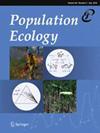Frequency‐dependent community dynamics driven by sexual interactions
IF 1
4区 环境科学与生态学
Q4 ECOLOGY
引用次数: 0
Abstract
Abstract Research in community ecology has tended to focus on trophic interactions (e.g., predation, resource competition) as driving forces of community dynamics, and sexual interactions have often been overlooked. Here we discuss how sexual interactions can affect community dynamics, especially focusing on frequency‐dependent dynamics of horizontal communities (i.e., communities of competing species in a single ecological guild). By combining mechanistic and phenomenological models of competition, we place sexual reproduction into the framework of modern coexistence theory. First, we review how population dynamics of two species competing for two resources can be represented by the Lotka–Volterra competition model as well as frequency dynamics, and how niche differentiation and overlap produce negative and positive frequency‐dependence (i.e., stable coexistence and priority effect), respectively. Then, we explore two situations where sexual interactions change the frequency‐dependence in community dynamics: (1) reproductive interference, that is, negative interspecific interactions due to incomplete species recognition in mating trials, can promote positive frequency‐dependence and (2) density‐dependent intraspecific adaptation load, that is, reduced population growth rates due to adaptation to intraspecific sexual (or social) interactions, produces negative frequency‐dependence. We show how reproductive interference and density‐dependent intraspecific adaptation load can decrease and increase niche differences in the framework of modern coexistence theory, respectively. Finally, we discuss future empirical and theoretical approaches for studying how sexual interactions and related phenomena (e.g., reproductive interference, intraspecific adaptation load, and sexual dimorphism) driven by sexual selection and conflict can affect community dynamics.由性互动驱动的频率依赖的群落动态
群落生态学的研究往往侧重于营养相互作用(如捕食、资源竞争)作为群落动态的驱动力,而性相互作用往往被忽视。在这里,我们讨论了性互动如何影响群落动态,特别是关注水平群落(即单一生态群落中竞争物种的群落)的频率依赖动态。通过结合竞争的机制模型和现象学模型,我们将有性生殖置于现代共存理论的框架中。首先,我们回顾了Lotka-Volterra竞争模型和频率动态如何表示两种物种竞争两种资源的种群动态,以及生态位分化和重叠如何分别产生负频率依赖和正频率依赖(即稳定共存和优先效应)。然后,我们探讨了两性互动改变群落动态中频率依赖性的两种情况:(1)生殖干扰,即由于交配试验中物种识别不完全而导致的负种间相互作用,可以促进正频率依赖性;(2)密度依赖性种内适应负荷,即由于适应种内两性(或社会)相互作用而导致的种群增长率降低,产生负频率依赖性。在现代共存理论的框架下,我们分别展示了生殖干扰和密度依赖的种内适应负荷如何减少和增加生态位差异。最后,我们讨论了未来研究由性选择和性冲突驱动的性互动和相关现象(如生殖干扰、种内适应负荷和两性二态性)如何影响群落动态的实证和理论方法。
本文章由计算机程序翻译,如有差异,请以英文原文为准。
求助全文
约1分钟内获得全文
求助全文
来源期刊

Population Ecology
环境科学-生态学
CiteScore
3.90
自引率
11.80%
发文量
41
审稿时长
18-36 weeks
期刊介绍:
Population Ecology, formerly known as Researches on Population Ecology launched in Dec 1952, is the official journal of the Society of Population Ecology. Population Ecology publishes original research articles and reviews (including invited reviews) on various aspects of population ecology, from the individual to the community level. Among the specific fields included are population dynamics and distribution, evolutionary ecology, ecological genetics, theoretical models, conservation biology, agroecosystem studies, and bioresource management. Manuscripts should contain new results of empirical and/or theoretical investigations concerning facts, patterns, processes, mechanisms or concepts of population ecology; those purely descriptive in nature are not suitable for this journal. All manuscripts are reviewed anonymously by two or more referees, and the final editorial decision is made by the Chief Editor or an Associate Editor based on the referees'' evaluations.
 求助内容:
求助内容: 应助结果提醒方式:
应助结果提醒方式:


